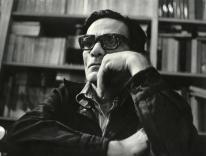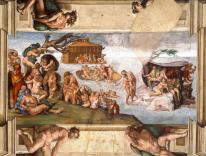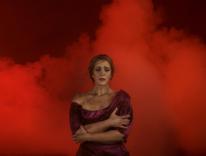Part of a visual pilgrimage toward Easter, this piece is the fourth in a series of spiritual meditations by Griffin Oleynick, who will visit a different art gallery each week through the season of Lent. Catch up on past installments here.
Tarsila do Amaral: Inventing Modern Art in Brazil, on view at the Museum of Modern Art in New York City, February 11 through June 3, 2018
Psalm 137, which we sing during the Liturgy of the Word this fourth Sunday of Lent, expresses in a few short verses the yearning of an exiled people longing to return home: “By the streams of Babylon / we sat and wept / when we remembered Zion.” This collective lament, sung by a chorus of sorrowful voices, invites each of us to add our own particular nostalgias: perhaps we have lost a job or a loved one, experienced the end of a friendship or romantic relationship, or find ourselves otherwise in transition. All growth, however positive, always entails loss, pulling us away from the familiar comforts of home. How then, as the liturgy suggests this Laetare Sunday, can we look beyond the momentary gray of grief and revel in the unfading colors of joy?
Tarsila do Amaral: Inventing Modern Art in Brazil, a new exhibition on view through June 3 at the Museum of Modern Art in New York, introduces us to an artist who transformed her hunger for home into some of the most spiritually exuberant and stylistically revolutionary paintings of the twentieth century. “I want to be the painter of my country,” Tarsila do Amaral wrote from Paris to her family back in São Paolo in 1923. Now nearly a century later the playful, captivating works of Tarsila (as she is fondly called in Brazil, where she has since become an icon of national identity, even providing some of the colors and patterns for the opening ceremonies at the 2016 Rio Olympics) have finally arrived in the United States for their first-ever monographic exhibition. The range of works on display is vast, and includes more than 120 individual objects drawn from collections across the United States, Latin America, and Europe. Yet the show still retains a small, intimate feel. Flowing naturally and organically, it gives the impression of spending time alone with Tarsila, enabling us to share in the thrilling sense of discovery that propelled her pioneering visual journey.
Rather than attempting to present a comprehensive retrospective of the artist’s entire career (Tarsila was born in 1886 and died in 1973), the exhibit’s curators have opted to focus on the 1920s, the pivotal decade in Tarsila’s stylistic development. Here she emerges as a seeker with a fundamental stance of openness toward the wondrous beauty of the world. Scrapbooks, letters, and photos document her steady search for new subjects, while numerous sketches and preparatory studies testify to her quick and easy assimilation of different visual styles (she dutifully completed her “military service in Cubism” with innovative masters like Fernand Léger). Living and working between diametrically opposite poles, avant-garde Paris at one end and rural Brazil at the other, Tarsila forged a signature style that fused the visual techniques of European modernism with explicitly Brazilian subjects, rendering them with a level of grace and dignity that had never before been achieved.
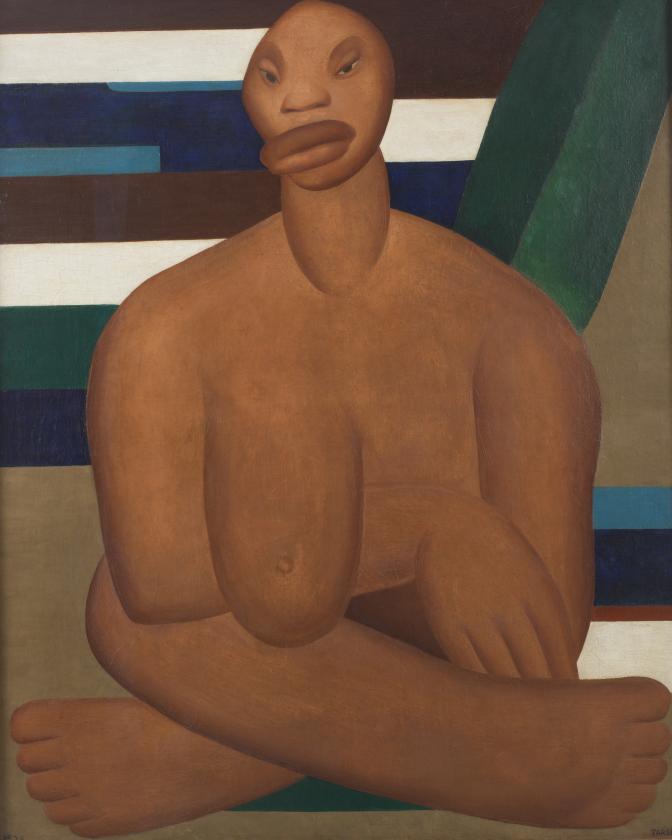
Among the most striking of such paintings is A Negra, or The Black Woman, Tarsila’s breakthrough that debuted in Paris in 1923. It signals a radical departure from earlier attempts to imitate Europeans like Léger (seen in paintings like Study [Academy No. 2]) and serves as an aggressive, liberating assertion of her feminine and Brazilian identities. The massive canvas is dominated by a nude female figure sitting cross-legged in front of a striped background, consisting of only a few bars of brown, blue, and white — indicative of land, sea, and sky — and a green banana leaf, which signifies Brazil. Her round, muscular features are abstracted from a photograph, displayed nearby, of a black Brazilian woman seated on a stairway and bathed in sunlight. Tarsila retains the woman’s hunched posture, emphasizing her broad shoulders, but strips everything else down to a few essential elements. The woman’s narrow eyes and her full, sealed lips signal an attitude of defiance and challenge, while her exposed breast and long right arm, which is draped protectively across her torso, affirm her capacity to offer both nourishment and safety. Provocative and maternal at the same time, A Negra proudly proclaims that from this point forward it is Brazil, not Paris, that feeds the hunger of Tarsila’s imagination.
Following her apprenticeship at the very center of the modernist art world, Tarsila deliberately struck out for the margins. Thus upon her return from France in the mid-1920s, she embarked upon a series of long, meandering trips through the Brazilian countryside with her husband, the poet Oswalde de Andrade. Amidst the idyllic landscapes and small towns surrounding her native São Paolo, Tarsila found new inspiration for her work, gradually turning her attention away from the trappings of modernity (like train stations, power lines, and factory towers) and pivoting instead to the natural features and cultural practices native to Brazil. Festive, energetic paintings of village scenes like Carnival in Madureira and Hills of the Favela give us a feel for the Edenic innocence that Tarsila perceived in her humble subjects, while the brilliant colors and smooth shapes of works like Manacá (the name of a Brazilian flower) and The Lake communicate the sense of purity and serenity that Tarsila discovered in nature. Her works from this period (which also include paintings like Brazilian Religion I, inspired by Brazilian Catholics’ devotion to Mary—unfortunately not part of the exhibit) build toward a pristine vision of cosmic harmony that embraces all things with equal warmth. The flat perspective and saturated hues in landscapes such as Postcard, completed in 1929, lend every object in the composition (cacti, palm trees, mountains, houses, and a pair of monkeys in a fruit tree) an almost tactile, corporeal quality—as if Tarsila wants to empower us to literally reach out and take hold of the same beauty she has witnessed.
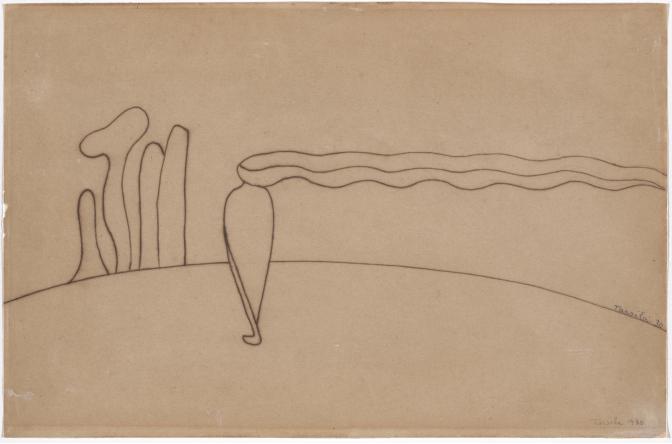
Tarsila’s stylistic innovations had ramifications beyond her immediate circle, sparking the birth of a groundbreaking national movement known as “Anthropophagy.”
The movement’s manifesto, penned by De Andrade, urged artists to “cannibalize” European influences and “swallow them whole” to create a uniquely Brazilian style of art. The novel metaphor implies that artistic innovation, rather than an act of rupture or rejection, is instead a process of consumption and digestion, one that metabolizes received forms into something absolutely new. Such novelty is on display in two of Tarsila’s most famous paintings, Abaporu (or “man that eats people” in the Tupi language) and Anthropophagy, which synthesized her insights gleaned over the course of the 1920s and established her as the preeminent Brazilian modernist. The latter, painted in 1929, shows two interlocking figures, male and female, seated peacefully in an abstract landscape. It crystallizes the sense of happiness and joy that resulted from Tarsila’s long, relentless quest to become “the painter of her country,” as her beloved Brazil becomes a new Eden, an earthly paradise that radiates the artist’s own inner harmony.
Sadly, such tranquility was not destined to last. That same year, Tarsila suffered a series of rapid setbacks that introduced a new dimension of heartache, disorientation, and pain into her work. The stock market crashed, leaving her almost entirely without assets, while her husband began an affair with a young actress, prompting a divorce. At the same time, Brazil’s government began a quick slide into dictatorship. Tarsila’s ideals had been shattered and her sense of stability ripped away.
Though it was the only painting that Tarsila completed in the year 1930, Lonely Figure stands as one of her most moving and personal works, communicating a well of emotion in a few simple shapes. A kind of abstract self-portrait, it shows a solitary female figure, her body shaped like a vase, standing in an empty plane as her long wavy hair, like smoke driven by an adverse wind, flows horizontally beyond the frame. This stark image evokes the concept of saudade, a Portuguese term that denotes the melancholy of solitude, the nostalgia felt in the absence of beloved persons and places. Despite Tarsila’s devastating losses, she nevertheless identifies a positive response to sadness that serves as an inspiring example to us all. With her foot planted firmly in the direction of a cluster of trees looming on the horizon, Tarsila’s Lonely Figure reveals her determination to continue her journey and face reality head on.
In Orthodox spirituality, the Lenten journey is marked above all by what the great Orthodox priest Alexander Schmemann once termed “bright sadness.” If Lent is in one sense a confrontation with darkness, a sorrowful acknowledgement of the reality of sin in our lives, it is at the same time a magnificent experience of God’s healing light. The central paradox of the season is that decline coexists with growth, death with life, pain with joy. The bright colors and cheerful images of Tarsila’s art, hardly an escapist flight from or a denial of reality, lead us to a similar conclusion: life on Earth is not perfect, but is instead shot through with inevitable moments of pain and suffering. Our task is not to let these hard facts obscure our vision of the world’s beauty.
Please email comments to [email protected] and join the conversation on our Facebook page.
Share
Previous Story
Great Friday
Next Story
A Failed Apostle
